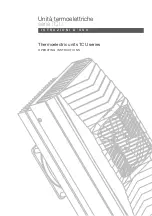
188
14 January 2021, SmartScanIS User’s Guide for Union Pacific, EUD-2016026-00 Rev.2
Wheel scanning alarms are limited to absolute only. To trigger a Hotwheel alarm, wheel
scanners must be properly installed, hotwheel detection must be enabled, and a wheel
temperature must exceed the limit that was established using the
Hotwheel option
on the
Alarm Limits submenu. This alarm limit is an offset, in degrees Fahrenheit, above the ambient
temperature. Hotwheel detection is enabled/disabled using the
Hotwheel option
on the
Equipment submenu. When enabled, the SmartScanIS detects and records every Hotwheel
alarm that occurs.
10.9 Auxiliary Alarms
The SmartScanIS can support input from as many as four external alarm devices. Any device
that provides an open relay contact upon alarm detection can be supported by the system.
Auxiliary alarms supported by the SmartScanIS are:
Dragging Equipment
. To trigger a Dragging-Equipment alarm, a dragging-equipment
detector must be properly installed, dragging-equipment detection must be enabled,
and the SmartScanIS must sense an open relay contact from the dragging-equipment
detector. Dragging-equipment detection is enabled/disabled using the
Dragger option
on the Equipment submenu. When enabled, the SmartScanIS detects and records
every Dragging-Equipment alarm that occurs on a given train.
When the SmartScanIS finds a pretrain Dragging-Equipment alarm, the system flags
the pretrain condition as an integrity failure, disables dragging-equipment scanning for
the remainder of the train, and doesn't assign a dragging-equipment condition to any of
the axles.
High Load
(aka oversized load). To trigger a High-Load alarm, a high-load detector
must be properly installed, high-load detection must be enabled, and the SmartScanIS
must sense an open relay contact from the high-load detector. High-load detection is
enabled/disabled using the
High-Load option
on the Equipment submenu.
The firmware's high-load logic is configured for use with a light-beam or trip-wire type
of high-load detector. Since Union Pacific uses the trip-wire type of high-load detector,
their devices generate the proper alarm signal when something breaks the connected
wire. Because a wire can only break once, the firmware only records one High-Load
alarm per train, regardless of the high-load status.
When the SmartScanIS finds a pretrain High-Load alarm, the system flags the pretrain
condition as an integrity failure, disables high-load scanning for the remainder of the
train, and doesn't assign a high-load condition to any of the axles.
Содержание SmartScanIS
Страница 1: ...EUD 2016026 00 Rev 2 SmartScanIS User s Guide for Union Pacific 14 January 2021...
Страница 82: ...82 14 January 2021 SmartScanIS User s Guide for Union Pacific EUD 2016026 00 Rev 2...
Страница 90: ...90 14 January 2021 SmartScanIS User s Guide for Union Pacific EUD 2016026 00 Rev 2...
Страница 130: ...130 14 January 2021 SmartScanIS User s Guide for Union Pacific EUD 2016026 00 Rev 2...
Страница 258: ...258 14 January 2021 SmartScanIS User s Guide for Union Pacific EUD 2016026 00 Rev 2...
Страница 376: ...376 14 January 2021 SmartScanIS User s Guide for Union Pacific EUD 2016026 00 Rev 2...
Страница 380: ...380 14 January 2021 SmartScanIS User s Guide for Union Pacific EUD 2016026 00 Rev 2...
















































